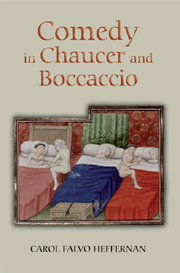Book contents
- Frontmatter
- Contents
- In memory Of Thomas Farel Heffernan 1933–2009
- Preface and Acknowledgments
- 1 Introductory matters
- 2 The Comic Inheritance of Boccaccio and Chaucer
- 3 Parallel Comic Tales in the Decameron and the Canterbury Tales
- 4 Antifraternal Satire in Boccaccio and Chaucer
- 5 Adding Comedy: Boccaccio's Filostrato and Chaucer's Troilus and Criseyde
- Conclusion
- Bibliography
- Index
- Chaucer Studies
Conclusion
Published online by Cambridge University Press: 12 September 2012
- Frontmatter
- Contents
- In memory Of Thomas Farel Heffernan 1933–2009
- Preface and Acknowledgments
- 1 Introductory matters
- 2 The Comic Inheritance of Boccaccio and Chaucer
- 3 Parallel Comic Tales in the Decameron and the Canterbury Tales
- 4 Antifraternal Satire in Boccaccio and Chaucer
- 5 Adding Comedy: Boccaccio's Filostrato and Chaucer's Troilus and Criseyde
- Conclusion
- Bibliography
- Index
- Chaucer Studies
Summary
The prayerful “Go litel bok, go, litel myn tragedye” at the end of Troilus and Criseyde looks forward hopefully “ther God thi makere yet, er that he dye,/ So sende might to make in som comedye.” No prayer could have been more fully answered than in the fabliaux of the Canterbury Tales. In borrowing Boccaccio's popular romance, Chaucer had much already worked out for him but his recreation of Pandaro as Pandarus set in motion the poet's natural comic spirit which reached its heights in the fabliaux of Chaucer's second masterpiece. The sad teller of Boccaccio's story transforms himself into the genial pilgrim-observer of the diversity of humankind who has an especially good ear for capturing stories, especially humorous ones. It is in using Boccaccio's Filostrato as the main source for Troilus and Criseyde that Chaucer discovered that the comic elements which he introduced into his “litel … tragedye” were worthy of repetition in a more extended comic enterprise. The fabliau thread that he spun out of Pandaro to produce Pandarus, architect of the love affair of Troilus and Criseyde, is the thread that becomes key to Fragment I of the Canterbury Tales.
Chaucer's comedy, however, is not so much derivative of Boccaccio's as part of a common European comic tradition that both poets inherited and revived. When Boccaccio and Chaucer drew on French fabliaux the vogue for that genre in medieval French literature had already passed.
- Type
- Chapter
- Information
- Comedy in Chaucer and Boccaccio , pp. 129 - 134Publisher: Boydell & BrewerPrint publication year: 2009



